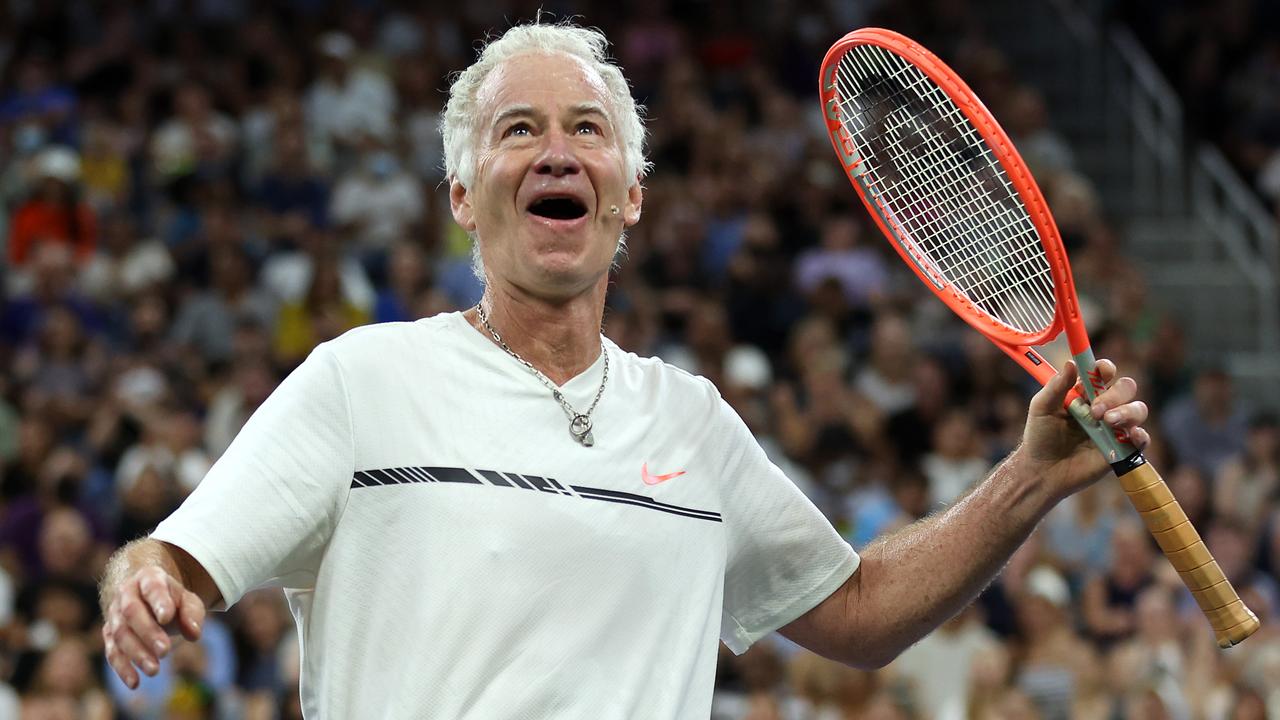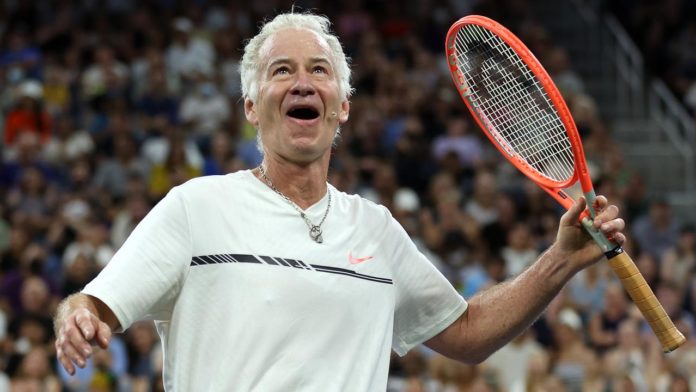
No tennis player is more closely associated with New York City than John McEnroe. He spoke with JASON GAY about some big pre-US Open talking points.
No tennis player is more closely associated with New York City than John McEnroe, the brilliant if volatile lefty who won his hometown US Open four times and continues to cover it as a TV analyst. Next weekend in the US, Showtime premieres “McEnroe,” a fresh look at the 63-year-old’s singular impact on tennis and pop culture. This conversation has been edited and condensed for clarity.
This appears to be Serena Williams’s last US Open. How do you think she’ll be remembered in tennis?
She’ll be remembered most for how great a tennis player she is. She’s up there with Michael Jordan. She’s like the ‘GOAT of GOAT’ type, like Tom Brady, Billie Jean King … to some degree Muhammad Ali. Muhammad Ali’s probably the top of all of them, but right below that are the Wayne Gretzkys of the world, Michael Jordan, LeBron James … She’s there. That’s quite an exalted area. It’s air that even champions don’t even feel.
To me, she’s the greatest female athlete in the history of any sport. Hopefully she’ll continue to be inspirational for young kids growing up, particularly kids of colour, to get into the sport, because let’s face it: This story comes along once every hundred years, her and Venus. Hopefully we can narrow that down so it could happen more often.
Is it true that Donald Trump offered you a million bucks to play her?
It is true. I can’t remember the exact year, but [Serena and Venus] were coming up. [Trump] used to have that box right next to the booth. I got a letter offering me to play either one of them. Then it was like, “What’s your response [to the offer]?” I go, “Well, that’s a good start.”
Novak Djokovic won’t play the Open because of current US rules stating he cannot enter the country as an unvaccinated non-citizen traveller. What is your opinion on that?
It’s a joke. It’s sad. It’s just really unfortunate that it’s come to this. Personally, as I’ve said, I would’ve gotten the vaccine, but maybe that’s why I have seven, and Novak’s got 21, because he sticks to his guns and that’s fuelled him in ways that most people can’t even imagine.
Look: He got thrown out of Australia. He could have won that, obviously. He could be in a different situation. Then you take one [major] away from Rafa, or maybe two, because I’m sure [bouncing back from Australia] took three months. You could tell his head wasn’t right. Physically, it took him to Wimbledon where he was all the way back, and now he goes through this again. It’s really a shame.
I don’t get what the problem is if you say he’s willing to take a test every day, for example. I mean, it’s really too bad.
In this new documentary, one thing that comes across is that despite the family support you had early on, you were tackling a lot of this alone. How different would tennis have been for you, do you think, had you been coming up today?
Difficult to say. It seems like pretty much all the top players have some type of team around them. A lot of times it includes family. Look: I love my parents, but as I was growing older, I didn’t necessarily want to be around them all the time. I preferred being a one-man entourage, more or less. Now, with the stakes being so much higher financially, for example, and the scrutiny in sports, you always want to reach as close to your peak as you can. I think as time has gone on, the methods to do that, obviously, and recovery, preparation, all that stuff, has changed. I think on some level I would’ve been doing myself a disservice had I not made more of an effort to do that.
Sometimes I do think: What would I have done? What would I do now in order to maximise my potential?
There’s dialogue in the film about the mental component of tennis. When you see the mental-health conversation happening today among players, whether it’s Naomi Osaka, or Andy Murray, or Nick Kyrgios, does it change your perspective about the way that players in your time cycled in and out of the game, like Borg leaving at 26?
My buddy Bjorn Borg is a perfect example of someone that was going through something. You could call it sort of that mental-health thing. That has come more to the forefront, particularly with the pandemic. Then Naomi Osaka obviously started things off, to a degree, but this is something that has been going on for a long time. I think it’s important that this topic becomes more open – obviously it needs to be.
Random, but for the tennis nuts out there: On your old Maxply, how did you prefer to have it strung?
You’re talking about my wood racquet, right?
Yeah.
Funnily enough, it’s sort of similar to the synthetic gut that people are using. Looser strings. It’s that trampoline effect – that’s what a lot of players use now, because otherwise their shoulders would fall off. I like that sort of redirect, use-the-opponent’s-power. I wasn’t looking like Rafael Nadal, so I had to try to generate power and throw people off and make people think it’s coming quicker than it was, with looser strings. Generally I’d say high 40s [tension]. Sometimes lower if it was at Wimbledon, because the balls may be a little heavier.
What do you think of potential rule changes, whether it’s people talking about no-lets, no-ad scoring, or even technological changes? One thing that sticks out from watching your matches is the net play. In a lot of cases, the racquet, the surface dictated playing style. There are ways to engineer the game – should tech options, surface options be considered?
Absolutely. It’s like watching a boxing match. If both guys are counter-punchers, it could be a little boring, so it’s nice to have contrast.
Look at this Maxime Cressy. He’s 30th in the world. They’re like, “Oh, my God, a serve/volleyer? A guy that actually does that?” He’s doing it pretty well. If the courts are quick, for example, that’s going to favour a guy or a girl who knows what the hell they’re doing at net.
That’s what Wimbledon did 20 years ago. Just think about this. You went through this period with Pete [Sampras] and Goran [Ivanisevic] and Boris [Becker], and then you saw this great match, [Patrick] Rafter-Ivanisevic. It went [9-7] in the fifth. Both players served and volleyed every point, first and second serve. The next year, [Lleyton] Hewitt plays [David] Nalbandian in the final. Neither one of them served and volleyed. I sat there, I couldn’t believe what I was watching. Now you watch Wimbledon, and I think the serve/volley percentage is like 10%, or 15% on the men’s side. It’s a drastic change.
I don’t think you should have a warm-up. These guys go in the locker room, they’re breaking a sweat, they’re on a bike. I mean, fighters go in the ring. Just think of a fighter going in a ring, and someone’s going to try to take their head off the first punch, potentially. It’s not like the first game of a tennis match, you’re going to have your head taken off. To me that would be more exciting, to have, “Ladies and gentlemen, Rafael Nadal! Then the other guy. Then you play. There are certainly things we should try to do to improve it.







